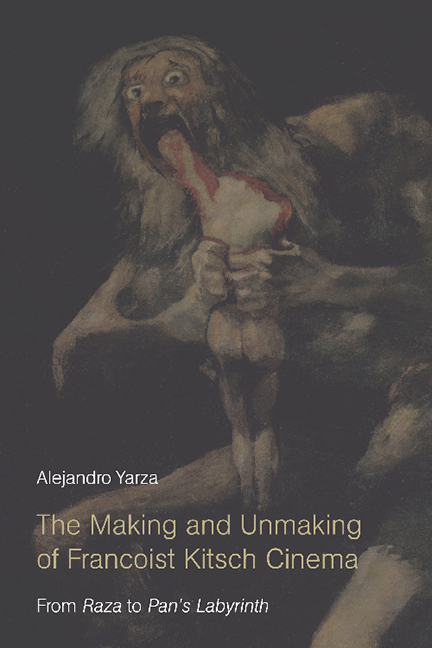Book contents
- Frontmatter
- Contents
- List of Figures
- Acknowledgments
- Preface
- Introduction
- 1 The Petrified Tears of General Franco: Kitsch and Fascism in José Luis Sáenz de Heredia’s Raza
- 2 Romancero Marroquí and the Francoist Kitsch Politics of Time
- 3 Los últimos de Filipinas: The Spatio-temporal Coordinates of Francoism
- 4 Surcos: Neorealism, Film Noir, and the Puppet Master
- 5 Franco, Ese Hombre: From Kitsch-Artist to Kitsch-Man
- 6 Viridiana: The World, the Flesh, and the Devil
- 7 Balada Triste De Trompeta: Of Ghosts and Clowns
- 8 Under the Sign of Saturn: The Labyrinth of Moral Choices in Francoist Spain
- Works Cited
- Index
1 - The Petrified Tears of General Franco: Kitsch and Fascism in José Luis Sáenz de Heredia’s Raza
Published online by Cambridge University Press: 10 November 2020
- Frontmatter
- Contents
- List of Figures
- Acknowledgments
- Preface
- Introduction
- 1 The Petrified Tears of General Franco: Kitsch and Fascism in José Luis Sáenz de Heredia’s Raza
- 2 Romancero Marroquí and the Francoist Kitsch Politics of Time
- 3 Los últimos de Filipinas: The Spatio-temporal Coordinates of Francoism
- 4 Surcos: Neorealism, Film Noir, and the Puppet Master
- 5 Franco, Ese Hombre: From Kitsch-Artist to Kitsch-Man
- 6 Viridiana: The World, the Flesh, and the Devil
- 7 Balada Triste De Trompeta: Of Ghosts and Clowns
- 8 Under the Sign of Saturn: The Labyrinth of Moral Choices in Francoist Spain
- Works Cited
- Index
Summary
La Patria es quien borda con mano de Mujer—de madre, de novia—sobre el pecho … el yugo y el haz, las flechas simbólicas de nuestro emblema
—José Antonio Primo de Rivera, Obras completasFrancoism—like German and Italian fascism—produced its own particular brand of kitsch, whose ultimate goal was to attain cultural and ideological hegemony over post-Civil War Spain. Francoist ideologues had utilized religious and historical iconography (particularly that derived from the centuries-long struggle of Spain against Islam) as a main element in the creation of a kitsch scenario intended to replace more complex accounts of Spain's historical past. Francoism and kitsch aesthetics came together to constitute and project a false and picturesque image of Spain. This aesthetic, and its closeness to the realm of political power, is best exemplified in the 1941 film Raza, directed by José Luis Sáenz de Heredia and based on a script written by Francisco Franco himself.
The text—part film script, part play, part novel—was written by Franco under the pseudonym Jaime de Andrade toward the end of 1940 and the beginning of 1941, and was published in 1942 as Raza: anecdotario para el guión de una película. It has been characterized as little more than a melodramatic political pamphlet lacking the “most basic aesthetic or psychological foundation” (Prado 104). I would argue, however, that Franco's text is not simply a political pamphlet written in a melodramatic style, but—like the film—exemplifies the kind of totalitarian kitsch aesthetics that suited the Francoist attempt to rewrite Spanish history in order to establish ideological hegemony over post-war Spain. Though the film was meant to be the blueprint for Francoist cinematic aesthetics, honed to the highest standards of serious art, it became the template for Francoist kitsch.
Raza was paradigmatic of a totalitarian kitsch aesthetic. By totalitarian kitsch aesthetic, I mean an aesthetic that, in Milan Kundera's words, erases “every display of individualism” as well as all doubt and irony (252). It is my contention that the film, like all totalitarian kitsch, restricted movement and produced a closing down of visual signifiers.
- Type
- Chapter
- Information
- The Making and Unmaking of Francoist Kitsch CinemaFrom Raza to Pan's Labyrinth, pp. 23 - 41Publisher: Edinburgh University PressPrint publication year: 2017



